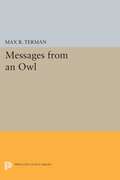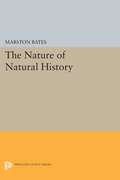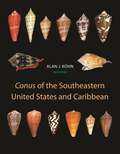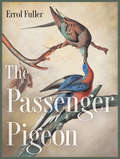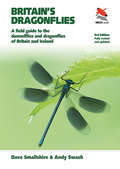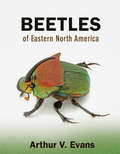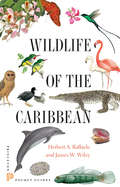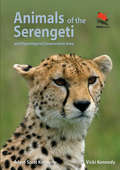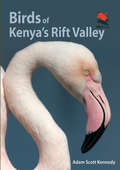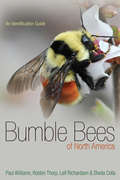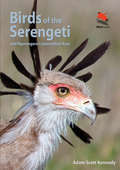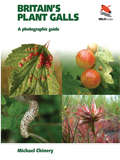- Table View
- List View
Where to Watch Birds in Africa
by Nigel WheatleyWhere to Watch Birds in Africa is a field guide designed to help birders and general wildlife enthusiasts organize the most enriching trips possible throughout this great continent. From Morocco to Madagascar, this book presents over 200 bird-watching sites in detail and describes the species endemic to Africa. The traveler will find practical information on climate, transportation, accommodations, health, and safety as well as advice on a number of strategic questions: Where can we see birds that epitomize the continent? Which country supports the best cross-section of species and the most endemics? How many sites must be visited to see most of these birds? How much time do these trips take and when is the best time to go? Featuring over one hundred maps and fifty-one line drawings, this book is not only a guide but also a handy reference.Following a chapter on how to use the book, there is an introduction to the continent and its birds. The countries, archipelagos, and islands are then dealt with alphabetically. General introductions to each country are followed by site details, which include bird lists; a list of other wildlife present, if applicable; and the latest information on where to look for the best birds.Originally published in 1995.The Princeton Legacy Library uses the latest print-on-demand technology to again make available previously out-of-print books from the distinguished backlist of Princeton University Press. These editions preserve the original texts of these important books while presenting them in durable paperback and hardcover editions. The goal of the Princeton Legacy Library is to vastly increase access to the rich scholarly heritage found in the thousands of books published by Princeton University Press since its founding in 1905.
Messages from an Owl
by Max R. TermanWhen zoologist Max Terman came to the rescue of a great horned owlet in a Kansas town park, he embarked on an adventure that would test his scientific ingenuity and lead to unprecedented observations of an owl's hidden life in the wild. In Messages from an Owl, Terman not only relates his experiences nursing the starving owlet, "Stripey," back to health and teaching it survival skills in his barn, but also describes the anxiety and elation of letting a companion loose into an uncertain world. Once Terman felt that Stripey knew how to dive after prey, he set the owl free. At this point his story could have ended, with no clue as to what the young bird's fate would be--had it not been for Terman's experimentation with radio tags. By strapping the tags to Stripey, he actually managed to follow the owl into the wild and observe for himself the behavior of a hand-reared individual reunited with its natural environment.Through this unique use of telemetry, Terman tracked Stripey for over six years after the bird left the scientist's barn and took up residence in the surrounding countryside on the Kansas prairie. The radio beacon provided Terman with information on the owl's regular patterns of playing, hunting, exploring, and protecting. It enabled him to witness the moments when Stripey was bantered and mobbed by crows, when other owls launched fierce attacks, and when a prospective mate caught Stripey's eye. On occasional returns to the barn, the owl would follow Terman around as he performed chores, usually waiting for a handout.Until now, scientists have generally believed that an owl nurtured by humans becomes ill-adapted for meeting the challenges of life in the wild. Terman's research proves otherwise. Stripey surpassed all expectations by becoming a totally independent wild creature. With Terman, however, Stripey remained tame, allowing the author to explore something one rarely sees in owls: a warm interest in humanity. Terman engagingly re-creates this dimension of Stripey as he describes with humor and compassion the daily challenges of probing the life of a "phantom winged tiger."Originally published in 1996.The Princeton Legacy Library uses the latest print-on-demand technology to again make available previously out-of-print books from the distinguished backlist of Princeton University Press. These editions preserve the original texts of these important books while presenting them in durable paperback and hardcover editions. The goal of the Princeton Legacy Library is to vastly increase access to the rich scholarly heritage found in the thousands of books published by Princeton University Press since its founding in 1905.
Where to Watch Birds in South America
by Nigel WheatleyA unique field guide and reference, Where to Watch Birds in South America is designed to help the avid birder and the general wildlife enthusiast organize eventful journeys throughout the richest continent for birds, where the species number over three thousand. This book covers more than two hundred of the best sites for birdwatching, and includes the archipelagos of Trinidad and Tobago, the Galapagos and Falkland Islands, the Netherland Antilles, and part of Antarctica. The reader will find details of every species that is endemic to particular countries, and will learn where and when best to see such birds as the scarlet ibis, Andean condor, harpy eagle, sunbittern, macaw, toucan, jacamar, antbird, and cotinga. The text is enhanced by nearly one hundred maps and fifty line drawings. There are even hints as to where species not seen for decades may be rediscovered.This guide begins with an introduction to the continent and its birds then deals with particular countries and archipelagos. The site details include bird lists, a list of other wildlife present, and the latest advice on where to look for birds. For the traveler, there is information on transport, accommodations, safety, and health, and answers to various strategic questions: Which countries support the most species? How many sites must be visited to see most of them? How long does this take? When is the best time to go? Whether a first-time visitor to South America or a seasoned traveler there, the reader will find this guide immensely useful in making the most out of the trip.Originally published in 1994.The Princeton Legacy Library uses the latest print-on-demand technology to again make available previously out-of-print books from the distinguished backlist of Princeton University Press. These editions preserve the original texts of these important books while presenting them in durable paperback and hardcover editions. The goal of the Princeton Legacy Library is to vastly increase access to the rich scholarly heritage found in the thousands of books published by Princeton University Press since its founding in 1905.
The Nature of Natural History
by Marston BatesThis classic work is an exploration of what natural history is, and a sustained effort to see how it relates to other areas of biology. Marston Bates did not attempt to overwhelm his audience with facts or overinterpret those he did use, and, perhaps for this reason, The Nature of Natural History is a timeless work. The author's genuine interest in the tropics has a very current feeling, and the first ten or fifteen chapters of the work have a style that is parallel to that of David Attenborough's verbal presentations of nature. From the book: "I have already made several remarks about the connection between parasitism and degeneracy. I suspect this is a matter of point of view. We are predatory animals ourselves, and consequently admire the characteristics of predationagility, speed, cunning, self-reliance. We feel a certain kinship with the lion, and regard the liver fluke with horror. If a sheep were given the choice, though, it might prefer to be debilitated by liver flukes rather than killed by a lion."Originally published in 1990.The Princeton Legacy Library uses the latest print-on-demand technology to again make available previously out-of-print books from the distinguished backlist of Princeton University Press. These editions preserve the original texts of these important books while presenting them in durable paperback and hardcover editions. The goal of the Princeton Legacy Library is to vastly increase access to the rich scholarly heritage found in the thousands of books published by Princeton University Press since its founding in 1905.
Everything In Its Place: Social Order and Land Use in America
by Constance PerinInterviews with bankers, civic leaders, politicians, and architects provide the basis for this searching analysis of the ways in which the physical arrangement of land expresses American ideals, assumptions, and beliefs.Originally published in 1977.The Princeton Legacy Library uses the latest print-on-demand technology to again make available previously out-of-print books from the distinguished backlist of Princeton University Press. These editions preserve the original texts of these important books while presenting them in durable paperback and hardcover editions. The goal of the Princeton Legacy Library is to vastly increase access to the rich scholarly heritage found in the thousands of books published by Princeton University Press since its founding in 1905.
"Conus" of the Southeastern United States and Caribbean (PDF)
by Alan J. KohnConus is the largest genus of animals in the sea, occurring throughout the world's tropical and subtropical oceans and contributing significantly to marine biodiversity. The shells of these marine mollusks are prized for their amazing variety and extraordinary beauty. The neurotoxic venoms they produce—injected by a hollow, harpoon-like tooth into prey animals that are then paralyzed and swallowed whole—have a range of pharmaceutical applications, from painkillers to antidepressants. This beautifully illustrated book identifies 53 valid species of the southeastern United States and the Caribbean, a region that supports a diverse but taxonomically challenging group of Conus. Introductory chapters cover the evolution and phylogeny of the genus, and notes on methodology are provided. Detailed species accounts describe key identification features, taxonomy, distribution, ecology, toxicology, life history, and evolutionary relationships. The book includes more than 2,100 photos of shells on 109 splendid color plates; more than 100 additional photos, many depicting live animals in color; and 35 color distribution maps.Identifies 53 valid species—the first reassessment of western Atlantic Conus in more than seventy yearsFeatures more than 2,100 photos of shells on 109 color platesBlends the traditional shell-character approach to identification with cutting-edge shell and radular tooth morphometrics and molecular genetic analysesIncludes color images of live animals as well as color distribution maps
"Conus" of the Southeastern United States and Caribbean
by Alan J. KohnConus is the largest genus of animals in the sea, occurring throughout the world's tropical and subtropical oceans and contributing significantly to marine biodiversity. The shells of these marine mollusks are prized for their amazing variety and extraordinary beauty. The neurotoxic venoms they produce—injected by a hollow, harpoon-like tooth into prey animals that are then paralyzed and swallowed whole—have a range of pharmaceutical applications, from painkillers to antidepressants. This beautifully illustrated book identifies 53 valid species of the southeastern United States and the Caribbean, a region that supports a diverse but taxonomically challenging group of Conus. Introductory chapters cover the evolution and phylogeny of the genus, and notes on methodology are provided. Detailed species accounts describe key identification features, taxonomy, distribution, ecology, toxicology, life history, and evolutionary relationships. The book includes more than 2,100 photos of shells on 109 splendid color plates; more than 100 additional photos, many depicting live animals in color; and 35 color distribution maps.Identifies 53 valid species—the first reassessment of western Atlantic Conus in more than seventy yearsFeatures more than 2,100 photos of shells on 109 color platesBlends the traditional shell-character approach to identification with cutting-edge shell and radular tooth morphometrics and molecular genetic analysesIncludes color images of live animals as well as color distribution maps
Trees of Eastern North America
by Gil Nelson Christopher J. Earle Richard Spellenberg Amy K. Hughes David MoreCovering 825 species, more than any comparable field guide, Trees of Eastern North America is the most comprehensive, best illustrated, and easiest-to-use book of its kind. Presenting all the native and naturalized trees of the eastern United States and Canada as far west as the Great Plains--including those species found only in tropical and subtropical Florida and northernmost Canada--the book features superior descriptions; thousands of meticulous color paintings by David More that illustrate important visual details; range maps that provide a thumbnail view of distribution for each native species; "Quick ID" summaries; a user-friendly layout; scientific and common names; the latest taxonomy; information on the most recently naturalized species; keys to leaves and twigs; and an introduction to tree identification, forest ecology, and plant classification and structure. The easy-to-read descriptions present details of size, shape, growth habit, bark, leaves, flowers, fruit, flowering and fruiting times, habitat, and range. Using a broad definition of a tree, the book covers many small, overlooked species normally thought of as shrubs. With its unmatched combination of breadth and depth, this is an essential guide for every tree lover.The most comprehensive, best illustrated, and easiest-to-use field guide to the trees of eastern North AmericaCovers 825 species, more than any comparable guide, including all the native and naturalized trees of the United States and Canada as far west as the Great PlainsFeatures specially commissioned artwork, detailed descriptions, range maps for native species, up-to-date taxonomy and names, and much, much moreAn essential guide for every tree lover
A Field Guide to the Larger Mammals of Tanzania (PDF)
by Charles Foley Lara Foley Alex Lobora Daniela De Luca Maurus Msuha Tim R.B. Davenport Sarah M. DurantHome to the Serengeti National Park, Ngorongoro Crater, and Mount Kilimanjaro, Tanzania offers some of the finest big game watching in the world, from elephants and rhinos to chimpanzees and lions. This field guide covers all the larger mammals of Tanzania, including marine mammals and some newly discovered species. Detailed accounts are provided for more than 135 species, along with color photos, color illustrations of marine mammals, and distribution maps. Accounts for land species give information on identification, subspecies, similar species, ecology, behavior, distribution, conservation status, and where best to see each species. The guide also features plates with side-by-side photographic comparisons of species that are easily confused, as well as first-time-ever species checklists for every national park.The definitive, most up-to-date field guide to the larger mammals of Tanzania, including marine mammalsFeatures detailed species accounts and numerous color photos throughoutProvides tips on where to see each speciesIncludes species checklists for every national park
The Two-Mile Time Machine: Ice Cores, Abrupt Climate Change, and Our Future
by Richard B. AlleyIn the 1990s Richard B. Alley and his colleagues made headlines with the discovery that the last ice age came to an abrupt end over a period of only three years. In The Two-Mile Time Machine, Alley tells the fascinating history of global climate changes as revealed by reading the annual rings of ice from cores drilled in Greenland. He explains that humans have experienced an unusually temperate climate compared to the wild fluctuations that characterized most of prehistory. He warns that our comfortable environment could come to an end in a matter of years and tells us what we need to know in order to understand and perhaps overcome climate changes in the future.In a new preface, the author weighs in on whether our understanding of global climate change has altered in the years since the book was first published, what the latest research tells us, and what he is working on next.
The Two-Mile Time Machine: Ice Cores, Abrupt Climate Change, and Our Future
by Richard B. AlleyIn the 1990s Richard B. Alley and his colleagues made headlines with the discovery that the last ice age came to an abrupt end over a period of only three years. In The Two-Mile Time Machine, Alley tells the fascinating history of global climate changes as revealed by reading the annual rings of ice from cores drilled in Greenland. He explains that humans have experienced an unusually temperate climate compared to the wild fluctuations that characterized most of prehistory. He warns that our comfortable environment could come to an end in a matter of years and tells us what we need to know in order to understand and perhaps overcome climate changes in the future.In a new preface, the author weighs in on whether our understanding of global climate change has altered in the years since the book was first published, what the latest research tells us, and what he is working on next.
The Passenger Pigeon
by Errol FullerAt the start of the nineteenth century, Passenger Pigeons were perhaps the most abundant birds on the planet, numbering literally in the billions. The flocks were so large and so dense that they blackened the skies, even blotting out the sun for days at a stretch. Yet by the end of the century, the most common bird in North America had vanished from the wild. In 1914, the last known representative of her species, Martha, died in a cage at the Cincinnati Zoo. This stunningly illustrated book tells the astonishing story of North America's Passenger Pigeon, a bird species that—like the Tyrannosaur, the Mammoth, and the Dodo—has become one of the great icons of extinction. Errol Fuller describes how these fast, agile, and handsomely plumaged birds were immortalized by the ornithologist and painter John James Audubon, and captured the imagination of writers such as James Fenimore Cooper, Henry David Thoreau, and Mark Twain. He shows how widespread deforestation, the demand for cheap and plentiful pigeon meat, and the indiscriminate killing of Passenger Pigeons for sport led to their catastrophic decline. Fuller provides an evocative memorial to a bird species that was once so important to the ecology of North America, and reminds us of just how fragile the natural world can be. Published in the centennial year of Martha’s death, The Passenger Pigeon features rare archival images as well as haunting photos of live birds.
Britain's Dragonflies: A Field Guide to the Damselflies and Dragonflies of Britain and Ireland, Fully Revised and Updated Third Edition
by Dave Smallshire Andy SwashBritain's Dragonflies is the only comprehensive photographic field guide to the damselflies and dragonflies of Britain and Ireland. Written by two of Britain’s foremost experts, this fully revised and updated edition features hundreds of stunning images and identification charts covering all 56 resident, migrant and former breeding species, and seven potential vagrants. The book focuses on identification--both of adults and larvae--highlighting the key features. Detailed species profiles provide concise information on identification, distribution, flight periods, behaviour, habitat, status and conservation. Other sections cover biology; how to watch, photograph, record and monitor Dragonflies; conservation status and legislation; and introduced exotic species.This redesigned, updated and expanded edition features: Beautiful colour plates showing males, females, immatures and all colour forms for every species Over 450 stunning photographs and 550 illustrations Up-to-date species profiles and distribution maps Detailed, easy-to-use identification charts for adults and larvae
Trees of Western North America
by Richard Spellenberg Christopher J. Earle Gil Nelson Amy K. Hughes David MoreCovering 630 species, more than any comparable field guide, Trees of Western North America is the most comprehensive, best illustrated, and easiest-to-use book of its kind. Presenting all the native and naturalized trees of the western United States and Canada as far east as the Great Plains, the book features superior descriptions; thousands of meticulous color paintings by David More that illustrate important visual details; range maps that provide a thumbnail view of distribution for each native species; "Quick ID" summaries; a user-friendly layout; scientific and common names; the latest taxonomy; information on the most recently naturalized species; a key to leaves; and an introduction to tree identification, forest ecology, and plant classification and structure. The easy-to-read descriptions present details of size, shape, growth habit, bark, leaves, flowers, fruit, flowering and fruiting times, habitat, and range. Using a broad definition of a tree, the book covers many small, overlooked species normally thought of as shrubs, as well as treelike forms of cacti and yuccas. With its unmatched combination of breadth and depth, this is an essential guide for every tree lover.The most comprehensive, best illustrated, and easiest-to-use field guide to the trees of western North AmericaCovers 630 species, more than any comparable guide, including all the native and naturalized trees of the United States and Canada as far east as the Great PlainsFeatures specially commissioned artwork, detailed descriptions, range maps for native species, up-to-date taxonomy and names, and much, much moreAn essential guide for every tree lover
Beetles of Eastern North America (PDF)
by Arthur V. EvansBeetles of Eastern North America is a landmark book--the most comprehensive full-color guide to the remarkably diverse and beautiful beetles of the United States and Canada east of the Mississippi River. It is the first color-illustrated guide to cover 1,406 species in all 115 families that occur in the region--and the first new in-depth guide to the region in more than forty years. Lavishly illustrated with over 1,500 stunning color images by some of the best insect photographers in North America, the book features an engaging and authoritative text by noted beetle expert Arthur Evans.Extensive introductory sections provide essential information on beetle anatomy, reproduction, development, natural history, behavior, and conservation. Also included are tips on where and when to find beetles; how to photograph, collect, and rear beetles; and how to contribute to research. Each family and species account presents concise and easy-to-understand information on identification, natural history, collecting, and geographic range. Organized by family, the book also includes an illustrated key to the most common beetle families, with 31 drawings that aid identification, and features current information on distribution, biology, and taxonomy not found in other guides.An unmatched guide to the rich variety of eastern North American beetles, this is an essential book for amateur naturalists, nature photographers, insect enthusiasts, students, and professional entomologists and other biologists.Provides the only comprehensive, authoritative, and accessible full-color treatment of the region's beetlesCovers 1,406 species in all 115 families east of the Mississippi RiverFeatures more than 1,500 stunning color images from top photographersPresents concise information on identification, natural history, collecting, and geographic range for each species and familyIncludes an illustrated key to the most common beetle families
Wildlife of the Caribbean
by Herbert A. Raffaele James WileyThis is the first comprehensive illustrated guide to the natural world of the Caribbean islands. It contains 600 vivid color images featuring 451 species of plants, birds, mammals, fish, seashells, and much more. While the guide primarily looks at the most conspicuous and widespread species among the islands, it also includes rarely seen creatures—such as the Rhinoceros Iguana and Cuban Solenodon—giving readers a special sense of the region's diverse wildlife.Each species is represented by one or more color photos or illustrations; details regarding its identification, status, and distribution; and interesting aspects of its life history or relationship to humans. In addition, an introductory section focuses on the unique characteristics of the Caribbean’s fauna and flora, the threats faced by both, and some of the steps being taken to sustain the area’s extraordinary natural heritage.Wildlife of the Caribbean is the essential field guide for learning about the living wonders in this area of the world.The only guide of its kind for the Caribbean islands600 detailed color images feature 451 amazing speciesStraightforward descriptions suitable for general audienceCompact size makes the guide easy to carry
Animals of the Serengeti: And Ngorongoro Conservation Area (PDF)
by Adam Scott Kennedy Vicki KennedyContaining 146 stunning color photos, Animals of the Serengeti is a remarkable look at the mammals and reptiles most likely to be encountered in the world-famous Serengeti National Park and Ngorongoro Crater. With an eye-catching layout, accessible text, and easy-to-use format, this detailed photographic guide includes 89 species of mammal and reptile. Useful "Top Tips"—shared by local Tanzanian guides that work in the region—provide visitors with insights into behavioral habits and how to locate specific animals. Filled with vivid anecdotes, Animals of the Serengeti will enable any safari traveler to identify the area's wildlife with ease.Covers the 89 species likely to be encountered in Tanzania’s Serengeti National Park and Ngorongoro Conservation Area Features male and female variationsAccessible text aimed at safari visitors of all levels
Birds of Kenya’s Rift Valley (PDF)
by Adam Scott KennedyKenya's Rift Valley includes four major national parks--Lake Nakuru, Lake Bogoria, Mount Longonot, and Hell's Gate--as well as many smaller areas that are outstanding for wildlife. Birds of Kenya's Rift Valley features the 320 bird species that are most likely to be encountered on safari in this world-famous region, which runs from Lake Baringo in the north to Lake Magadi in the south. Featuring over 500 stunning color photos, this beautiful guide breaks new ground with its eye-catching layout and easy-to-use format. The book follows a habitat-based approach and provides interesting information about the ecology and behaviors of each species. Birds of Kenya's Rift Valley avoids technical jargon in the species descriptions, which makes the guide easily accessible to anyone. With it, you will be identifying birds in no time.Stunning photos of 320 bird speciesMajor plumage variations depictedJargon-free textHelpful notes on what to look and listen for, behavior, and why some birds are so named
Bumble Bees of North America: An Identification Guide (PDF)
by Paul H. Williams Robbin W. Thorp Leif L. Richardson Sheila R. CollaMore than ever before, there is widespread interest in studying bumble bees and the critical role they play in our ecosystems. Bumble Bees of North America is the first comprehensive guide to North American bumble bees to be published in more than a century. Richly illustrated with color photographs, diagrams, range maps, and graphs of seasonal activity patterns, this guide allows amateur and professional naturalists to identify all 46 bumble bee species found north of Mexico and to understand their ecology and changing geographic distributions.The book draws on the latest molecular research, shows the enormous color variation within species, and guides readers through the many confusing convergences between species. It draws on a large repository of data from museum collections and presents state-of-the-art results on evolutionary relationships, distributions, and ecological roles. Illustrated keys allow identification of color morphs and social castes.A landmark publication, Bumble Bees of North America sets the standard for guides and the study of these important insects.The best guide yet to the 46 recognized bumble bee species in North America north of MexicoUp-to-date taxonomy includes previously unpublished results Detailed distribution maps Extensive keys identify the many color patterns of species
Bumble Bees of North America: An Identification Guide
by Paul H. Williams Robbin W. Thorp Leif L. Richardson Sheila R. CollaMore than ever before, there is widespread interest in studying bumble bees and the critical role they play in our ecosystems. Bumble Bees of North America is the first comprehensive guide to North American bumble bees to be published in more than a century. Richly illustrated with color photographs, diagrams, range maps, and graphs of seasonal activity patterns, this guide allows amateur and professional naturalists to identify all 46 bumble bee species found north of Mexico and to understand their ecology and changing geographic distributions.The book draws on the latest molecular research, shows the enormous color variation within species, and guides readers through the many confusing convergences between species. It draws on a large repository of data from museum collections and presents state-of-the-art results on evolutionary relationships, distributions, and ecological roles. Illustrated keys allow identification of color morphs and social castes.A landmark publication, Bumble Bees of North America sets the standard for guides and the study of these important insects.The best guide yet to the 46 recognized bumble bee species in North America north of MexicoUp-to-date taxonomy includes previously unpublished results Detailed distribution maps Extensive keys identify the many color patterns of species
Birds of the Serengeti: And Ngorongoro Conservation Area (PDF)
by Adam Scott KennedyLocated in northern Tanzania, the Serengeti is one of the world's most famous wildlife regions. Birds of the Serengeti is a groundbreaking and essential photographic guide, featuring more than 270 bird species most likely to be encountered in the Serengeti National Park and Ngorongoro Conservation Area. This easy-to-use guide includes 480 dazzling color photos, an attractive and handy layout, and informative and accessible text that discusses interesting behaviors and provides insights into species background. Rich in detail, this indispensable volume uses a habitat-based approach, making it simple for everyone—from the novice to the experienced birdwatcher—to locate diverse birds in this fascinating area of the world.Looks at more than 270 bird species most likely to be encountered in Tanzania’s Serengeti National Park, Ngorongoro Conservation Area, and Speke Gulf Features major plumage variations Habitat-based approachInformative and accessible text
Britain's Plant Galls: A Photographic Guide (PDF)
by Michael ChineryThis book has been produced with the aim of stimulating the general naturalist to take a closer look at the bumps and lumps that make up the fascinating world of plant galls. Induced by a variety of insects and other organisms and ranging from tiny pimples to bizarre and often very attractive and exquisitely sculptured growths, plant galls are mystery to many people, but they offer a fascinating field of study for both botanists and zoologists. Galls can be found on a very wide range of both woody and herbaceous plants, with over 50 different kinds occurring on Britain's oak trees alone, and there is still much to be learned about even the commonest examples. An introduction to the nature of plant galls and their formation Brief descriptions of some of the organisms that cause or induce galls Superb photographs of just over 200 of the commonest or most conspicuous of Britain's 1,000 or so plant galls, arranged according to their host plants to aid field identification Descriptions of these galls and the life histories of the organisms that cause them
A Sparrowhawk's Lament: How British Breeding Birds of Prey Are Faring (PDF)
by David Cobham Bruce Pearson Chris PackhamBritain is home to fifteen species of breeding birds of prey, from the hedgerow-hopping Sparrowhawk to the breathtaking White-tailed Eagle. In this handsomely illustrated book, acclaimed British filmmaker and naturalist David Cobham offers unique and deeply personal insights into Britain's birds of prey and how they are faring today. He delves into the history of these magnificent birds and talks in depth with the scientists and conservationists who are striving to safeguard them. In doing so, he profiles the writers, poets and filmmakers who have done so much to change the public's perception of birds of prey. There are success stories—five birds of prey that were extinct have become reestablished with viable populations—but persecution is still rife. Featuring drawings by famed wildlife artist Bruce Pearson, this book reveals why we must cherish and celebrate our birds of prey, and why we neglect them at our peril.
A Sparrowhawk's Lament: How British Breeding Birds of Prey Are Faring
by David Cobham Bruce Pearson Chris PackhamBritain is home to fifteen species of breeding birds of prey, from the hedgerow-hopping Sparrowhawk to the breathtaking White-tailed Eagle. In this handsomely illustrated book, acclaimed British filmmaker and naturalist David Cobham offers unique and deeply personal insights into Britain's birds of prey and how they are faring today. He delves into the history of these magnificent birds and talks in depth with the scientists and conservationists who are striving to safeguard them. In doing so, he profiles the writers, poets and filmmakers who have done so much to change the public's perception of birds of prey. There are success stories—five birds of prey that were extinct have become reestablished with viable populations—but persecution is still rife. Featuring drawings by famed wildlife artist Bruce Pearson, this book reveals why we must cherish and celebrate our birds of prey, and why we neglect them at our peril.
Ocean Biogeochemical Dynamics
by Jorge L. SarmientoOcean Biogeochemical Dynamics provides a broad theoretical framework upon which graduate students and upper-level undergraduates can formulate an understanding of the processes that control the mean concentration and distribution of biologically utilized elements and compounds in the ocean. Though it is written as a textbook, it will also be of interest to more advanced scientists as a wide-ranging synthesis of our present understanding of ocean biogeochemical processes. The first two chapters of the book provide an introductory overview of biogeochemical and physical oceanography. The next four chapters concentrate on processes at the air-sea interface, the production of organic matter in the upper ocean, the remineralization of organic matter in the water column, and the processing of organic matter in the sediments. The focus of these chapters is on analyzing the cycles of organic carbon, oxygen, and nutrients. The next three chapters round out the authors' coverage of ocean biogeochemical cycles with discussions of silica, dissolved inorganic carbon and alkalinity, and CaCO3. The final chapter discusses applications of ocean biogeochemistry to our understanding of the role of the ocean carbon cycle in interannual to decadal variability, paleoclimatology, and the anthropogenic carbon budget. The problem sets included at the end of each chapter encourage students to ask critical questions in this exciting new field. While much of the approach is mathematical, the math is at a level that should be accessible to students with a year or two of college level mathematics and/or physics.

